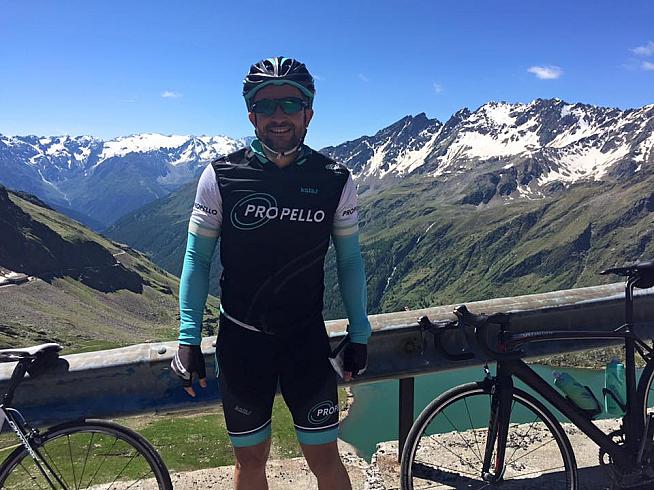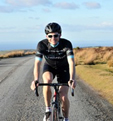As some of you know I recently went to the Italian Alps and Dolomites, taking on 700 km/450 miles and 20,000m/65,000 feet of climbing over six days' riding. It was a fantastic trip with good weather, great food and proper coffee.
I went with two friends, both of whom are experienced cyclists, but one in particular, Simon, is annoying. He is a great climber - at 68kg/150lbs and what I expect is an FTP of around 280w (although he is old school and just pushes the pedals hard!). His 4.12wkg means that I either have to lose 9kg/20lbs or gain around 35w to keep up with him!
But to add insult into injury he is also a terrific descender, so he kills you on the climbs and then rubs salt into the wounds by increasing his lead on the descents. So many people I see spend an awful long time building fitness to climb but NEVER practise and develop descending skills - every climb has a descent! It is just like the golfer that goes to the range and smashes 200 balls into the back net and never practises putting!

Simon has been riding properly for years, and I mean 30+ years so I asked him if he would mind sharing some of his wisdom and experience to help you 'Descend (more) like a Pro'!
_________
Descending skills
Warning - this article contains no references to watts, FTP, BPM or the like. It is about speed for free, and having some fun. What is not to like?
First, a salutary tale. A couple of summers ago, I rode up Mont Ventoux. A decent rider I was with smashed it on the way up in under 1 hour 20. He is an athlete who works really hard on his training - putting in turbo sessions that put me to shame. I caught him on the way down. As I passed him, he was gripping the brakes for grim death, backside up in the air, wobbling around the corners; the nerves were there for all to see. My descent was fast, but safe - I took no risks. And I had a smile like a Cheshire cat.
As long as you have a decent set of tyres and the brakes are working, none of this speed depends on expensive kit or an unnatural VO2 max (whatever that is).
Here are my tips, gleaned from many years in the saddle. Let's look at the mindset first.
A healthy dose of fear
Before any race or event, I always remind myself that my number one priority is to finish safely. I do not get paid to ride my bike (I don't even get paid for this article). I have a family who I love very much, most of the time. My objective is to get back to them in one piece. Cycling can be dangerous, but there is not too much out there that you cannot control or influence. Fear and caution are important, but they should not inhibit your bike handling or your state of mind. That is where practice and experience come in.
Practice makes perfect
Descending is a skill, like any other. It can be improved. Practice gives you confidence. Confidence is the key to descending quickly and safely.
Another story - I was recently riding with someone (who will probably now be nodding his head in recognition) who - after a two hour climb - was getting in the van for the descents. When quizzed about this, said rider answered that he was happy to push a load of power up the climbs but that there was no training benefit to be had on the descents; that rider lost 4 minutes 30 to me on a single 13 km/8 mile descent. Rob probably has an equation for how much extra power it would take to make up that sort of time on a climb.
Like learning any skill though, it is best to start off slowly and build from there. Pick a local descent with a decent surface and good visibility to start with. Do it a few times, until you are confident and feel relaxed on that descent. Then move to more technical descents from there.
When I am doing a mountainous sportive, if I get the chance, I will recon the descents as much as the climbs - taking them at ease and mentally noting where to go fast and where to be cautious. Over a 15 minute descent, I reckon I could probably save a minute or two, just through being a bit more familiar with the territory.
Watch and learn
When riding with others, you can always learn from their strengths and weaknesses. My boss, who is Belgian, drops from a climb like a lead weight and I have never seen him get into the remotest spot of bother. (Shame he climbs like one too, though.)
Smooth FM
I am a Top Gear fan. You might remember seeing Lewis Hamilton going round the Top Gear track. Calm and relaxed, no drama - he didn't even look that fast. Yet he did something like 1'41". Take a look at some YouTube clips of professionals descending. Most of the time they are floating round the corners, in complete control of their bikes. Shoulders relaxed, low on the bike. Like watching a ballet.
But they do not always get it right - check out stage 16 of last year's Tour, the descent of the Col de Manse for some great descending but also some unnecessary risks - see Geraint Thomas launched into a telegraph pole. Even the great Peter Sagan has to apply the anchors. But the key is that he follows the next rule...
Don't panic
There may be times when you feel you have overcooked an approach to a corner or there is something unexpected in the road. Nothing good will come of panicking in this situation. Be calm and trust your skills - chances are that you can avoid the problem if you stay in control of the bike.
Let's look at some more technical stuff.
On the drops please
Your weight distribution on the bike is key. Getting on the drops with your bum back on the saddle spreads the weight over the bike, and gives you better balance. It also gives you greater control over the brakes, and keeps you nice and low when compared to riding with hands on the hoods.
When cornering, outside leg at the 6 o'clock position, with your weight pressed down on that foot. For hairpins, you will probably find yourself leaning harder on the inside hand down into the corner.
When you watch the pro's, you will see they shift their upper body position away from the corner slightly, even though the inside knee may be pointing down. This helps to keep the balance in the right place, evenly over the tyres. Note that this is not the same as MotoGP, where the motorbike riders lean their bodies into the corner - that is because their motorbikes are much heavier than your 7kg carbon beauty.

Brake in a straight line
Ahead of the corner, so you go into it at the right speed to get round the bend safely. It is fine to hold on to the brakes on a steep hairpin, to keep your speed the same until you can see the exit of the bend when you can fully release. Remember, it is better to be slow into the corner and fast out of it. Think Lewis Hamilton.
Braking balance
Front or back? I don't really think about it too much, I prefer to focus on the balance and the speed of entry into the corner. The front will give you more power, but I often find myself applying the rear a moment before the front, to make sure I have control. I don't know (or care) if there is any science behind that.
Grip always trumps speed
The dry or gravel-free part of the road may not be the racing line. Always take the safer option, and scrub your speed ahead of the danger zone.
Look ahead
Particularly through the corners - it helps you to flow round the bends and see the traffic. Not down at the ground - trust your peripheral vision for rough roads.
On a long unfamiliar descent, I will sometimes glance down at the Garmin, on the map page. If the map scale is set to something like 300m/1,000 feet, you can get a feel for whether there are upcoming hairpins, junctions or technical sections. No point in looking at your power meter!
Right side of the line
There are very few closed road events, where you have your pick of the racing line. And even those events are likely to be littered with riders who are not confident descenders. It is simply not worth the risk of crossing that central line.
Don't gamble on blind corners; hold your speed until you can see the exit.
Trust your tyres
Whatever you choose to spend your money on, make sure you have decent tyres. You will be amazed how much grip they can give you. The latest clincher tyres are nearly up there with tubular tyres for cornering speed. I have tried most brands of tyre. I always come back to Conti GP4000S, in 25mm. They are the best combination of durability, speed and grip. I am 68kgs/150lbs, and pump them to 90PSI. Again, for me, this gives good comfort and cornering. In the wet, I will take the pressure down by 5-10PSI, for added security.
Aluminium may be old school, but...
Your carbon deep section rims may look great, and serve as a super advertising board for the wheel manufacturer. But even the best carbon braking is not quite up there with aluminium rims, especially in the wet. So at the outset at least, stick with the traditional.
Zip it
A flapping gilet or jersey on a descent is a crime. You might as well attach a sail to your bike.
A further statement of the obvious.
Your ability to descend safely is best in warm, dry conditions. If it is cold and/or wet, you will not have the same grip. Also the road surface is key. A heavy downpour after a dry spell requires extra caution. Any sign of ice, stay on the trainer.
_________
I hope that you found Simon's tips useful. Remember that mastering descending is speed for free. Just think about all those hours you might spend training or effort you might put into losing weight to make say two minutes on a climb. I bet all of you that with better skills you can shave multiple minutes off every ride with better descending skills and be a safer rider as well!
P.S. - Although Chris Froome was mightily impressive on Stage 8 on the Tour in the final descent we don't recommend this technique for the average club rider!
Rob Wakefield is a fully qualified Level 3 Cycling Coach with the Association of British Cycling Coaches and founder of Propello, a cycling focused health and fitness business delivering Performance Training Programmes and Bespoke Coaching to cyclists anywhere in the world.
All cyclists who are looking to improve their speed, endurance or strength will benefit from a structured training programme. Propello Training will improve how your muscles, lungs and heart work and will enable your body to transport and utilise fuel effectively - making you faster and stronger for longer.
Click here to learn more about Propello.
0 Comments





